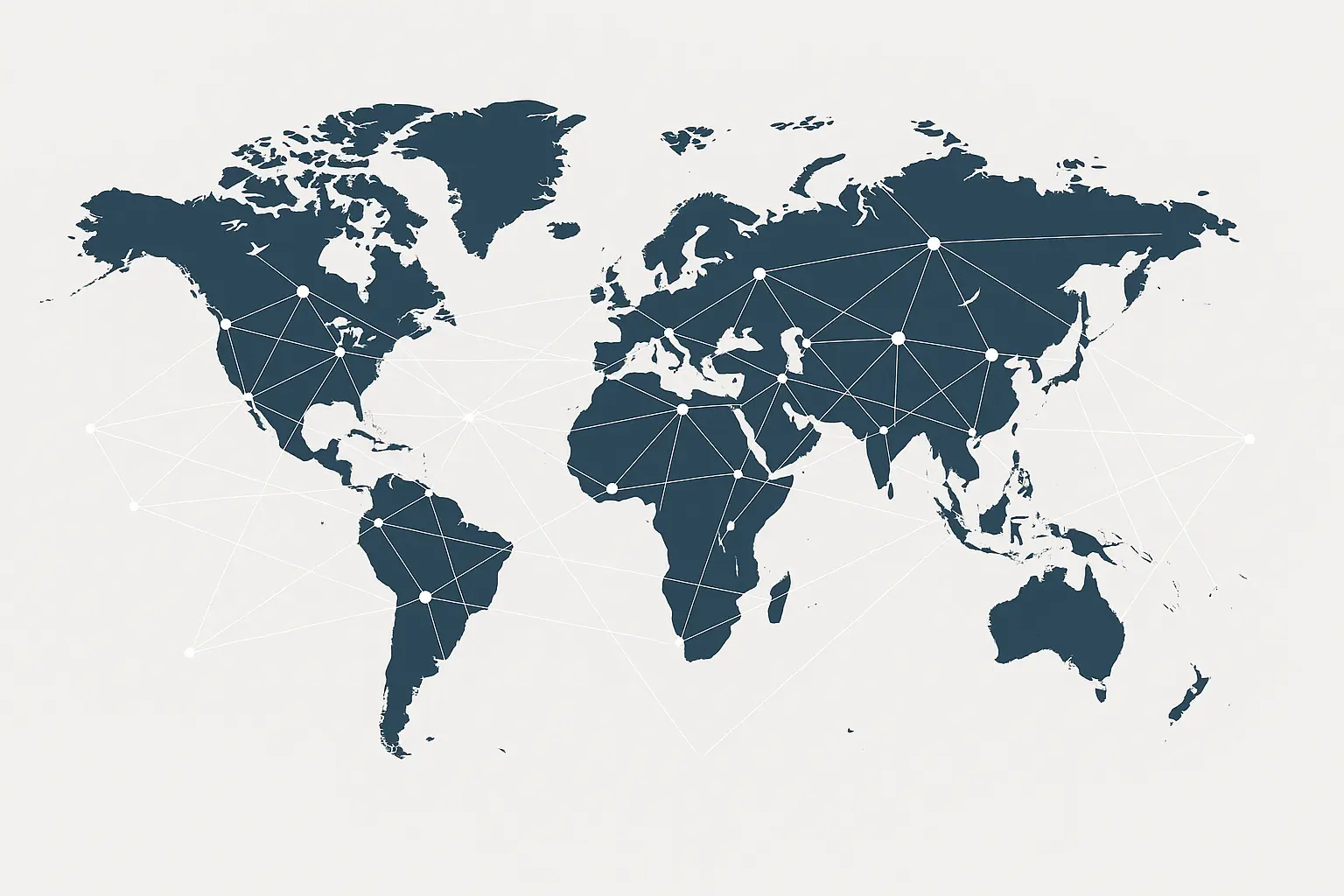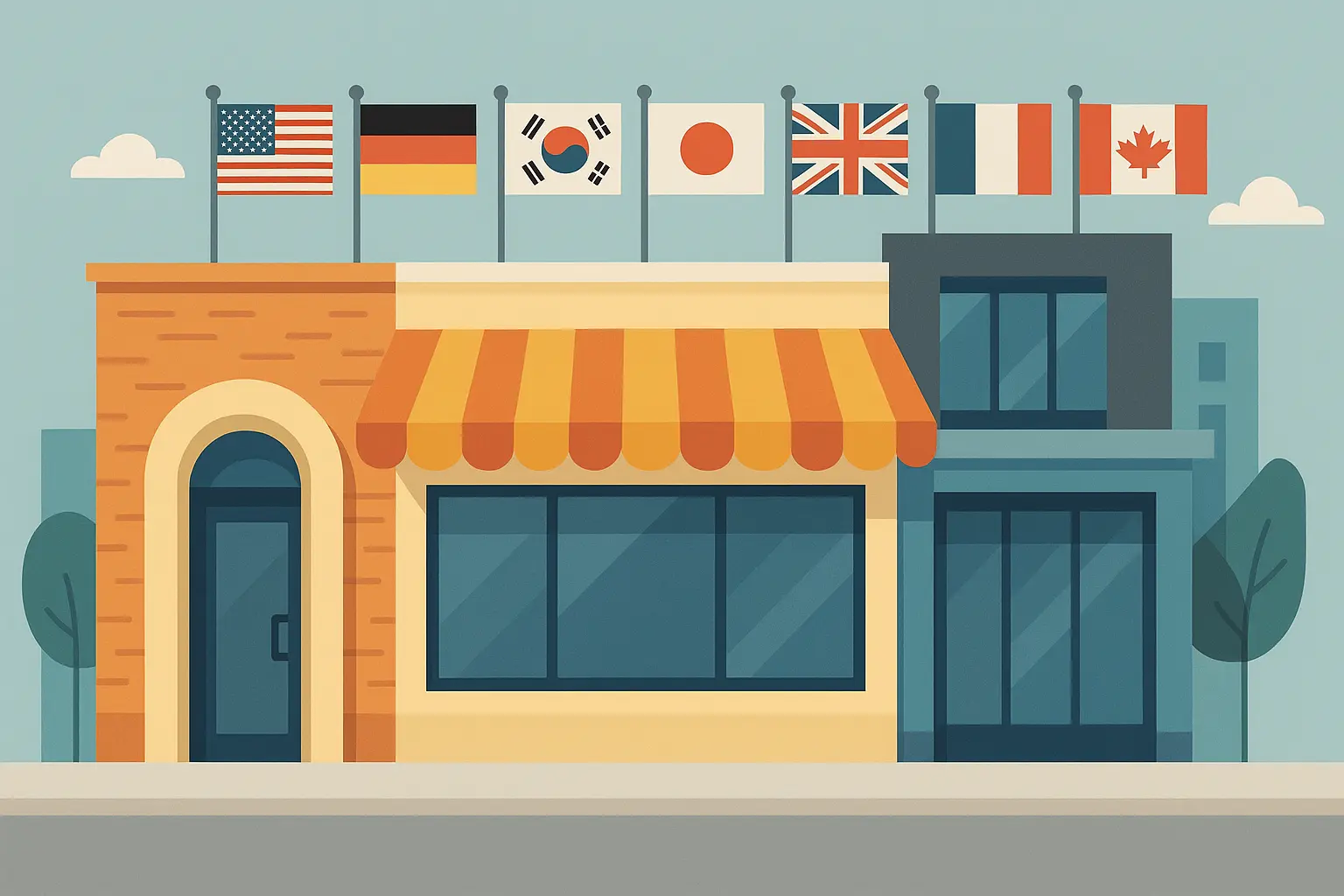I’ll be honest with you – watching companies crash and burn in international markets never gets easier. Last month, I watched a promising startup blow through $2 million in six months trying to crack the European market. They made every mistake in the book – assumed their domestic success would translate directly, ignored local preferences, and burned through cash without testing their assumptions.
According to recent research, companies with strong international marketing strategies see 23% higher revenue growth compared to those focused solely on domestic markets, and businesses that study successful global expansion case studies are 40% more likely to avoid costly international marketing mistakes.
I’ve spent years analyzing what separates successful global brands from those that crash and burn in foreign markets. The difference isn’t luck—it’s strategy, cultural intelligence, and learning from others who’ve already paved the way. These 25 case studies represent the gold standard of international marketing excellence, each offering unique insights that could revolutionize how you approach global expansion.

Table of Contents
- How to Evaluate International Marketing Case Studies Like a Pro
- Digital-First Global Expansion Champions
- Traditional Retail Powerhouses Going Global
- Technology Giants Conquering International Markets
- Consumer Goods Masters of Localization
- Financial Services Breaking Global Barriers
- Automotive Leaders Driving International Success
- Deep Dive Analysis: What Makes These Strategies Work
- Performance Metrics That Actually Matter
- Risk Assessment Framework for Global Success
- Innovation Strategies That Scale Across Borders
- How The Marketing Agency Can Accelerate Your International Growth
- Final Thoughts
TL;DR
- Successful international marketing requires balancing brand consistency with local cultural adaptation
- Digital-first companies like Netflix and Spotify achieve faster global penetration through scalable technology platforms
- Traditional retailers succeed internationally by combining standardized operations with localized customer experiences
- Strategic partnerships and joint ventures reduce risk while providing essential local market knowledge
- Data-driven decision making separates successful global brands from those that fail due to cultural assumptions
- Premium positioning can transcend cultural boundaries when supported by consistent quality and customer experience
- Crisis management capabilities and adaptability determine long-term international success
How to Evaluate International Marketing Case Studies Like a Pro
Look, evaluating international marketing case studies isn’t about cherry-picking success stories that make you feel good about your expansion plans. You need a no-BS way to figure out what actually works and what’s just marketing fluff.
When I first started analyzing international campaigns, I thought some companies were just lucky. Boy, was I wrong. The successful ones have systematic approaches that cut through the noise and get to real strategic insights.
When analyzing these cases, it’s crucial to understand how advanced analytics drive strategic growth across different markets and cultural contexts.
Strategic Alignment: The Foundation of Success
Here’s the thing that makes or breaks everything: your market entry strategy has to match reality, not your wishful thinking. Companies approach new markets through direct investment, partnerships, franchising, or digital-first strategies. Each approach carries different risk profiles and resource requirements, and picking the wrong one can kill your expansion before it starts.
Cultural adaptation versus standardization? It’s like walking a tightrope between staying true to your brand and not looking like a clueless outsider. Some brands maintain rigid consistency (think Apple’s design philosophy), while others embrace radical localization (McDonald’s country-specific menus). The sweet spot depends on your industry, target audience, and brand positioning – there’s no one-size-fits-all answer.
| Market Entry Strategy | Risk Level | Time to Market | Resource Requirements | Best For |
|---|---|---|---|---|
| Direct Investment | High | 12-24 months | Very High | Large enterprises with significant capital |
| Joint Ventures | Medium | 6-12 months | High | Companies seeking local expertise |
| Franchising | Low-Medium | 3-6 months | Medium | Scalable business models |
| Digital-First | Low | 1-3 months | Low-Medium | Technology and service companies |
| Licensing | Low | 3-6 months | Low | IP-rich companies |
Timeline and scalability determine whether a strategy can actually be replicated across multiple markets. Netflix’s content localization model scales beautifully because it’s built on technology and data. Starbucks’ store-by-store expansion requires more time and resources but creates deeper local connections that are harder for competitors to replicate.
Performance Metrics That Cut Through the Noise
ROI and financial performance provide the clearest success indicators, but here’s where most companies mess up – they look at revenue numbers without understanding the context. Don’t just examine market share gains – look at profitability margins and customer acquisition costs across different regions. A 20% market share gain that costs you twice as much per customer isn’t necessarily success.
Market penetration speed varies dramatically by industry and approach, and understanding this prevents unrealistic expectations. Digital services can achieve rapid penetration because they don’t need physical infrastructure. Physical retail requires patient, methodical expansion because you’re building stores, training staff, and establishing supply chains.
Brand recognition metrics reveal how well companies translate their value proposition across cultures. But strong international brands don’t just maintain consistent core messaging – they adapt delivery methods to local preferences without losing their identity.
Risk Assessment: Learning from Others’ Mistakes
Political and economic stability considerations can make or break international strategies, and I’ve seen too many companies ignore this until it’s too late. Companies that thoroughly assess local market conditions before entry consistently outperform those that assume global markets operate identically to their home market.
Competitive landscape analysis reveals whether markets are saturated or ripe for disruption. But here’s what most miss – understanding local AND international competitors helps identify positioning opportunities and potential threats. Sometimes your biggest competition comes from unexpected places.
Regulatory compliance challenges vary significantly by country and industry. Financial services face stricter requirements than consumer goods, while digital platforms navigate complex data privacy regulations across jurisdictions. The companies that succeed plan for regulatory complexity instead of hoping it won’t matter.
Digital-First Global Expansion Champions
Digital-first companies have it easier in some ways – software doesn’t need different factories for different countries. Their scalable technology platforms eliminate many traditional barriers to global growth, enabling rapid market entry and efficient resource allocation. But they face their own unique challenges with regulations, local competition, and cultural adaptation.

1. Netflix’s Content Localization Revolution
Netflix’s strategy is like being that friend who always knows exactly what movie you want to watch, except they do it for 200 million people across different cultures. They transformed international expansion by investing heavily in local content creation while maintaining global platform consistency.
But here’s what’s brilliant – their approach goes way beyond translation. They create culturally relevant original programming that resonates with local audiences while appealing to global viewers. It’s not about dubbing American shows into different languages; it’s about understanding what stories matter to people in different cultures.
When Netflix entered India, they didn’t just translate American shows into Hindi. Instead, they created “Sacred Games,” a crime thriller that addressed local social issues and featured Bollywood stars. The show became their most-watched non-English series globally, demonstrating how local content can achieve international appeal while establishing market credibility.
Even Netflix screwed this up initially. Their first international launches were basically “here’s American content with subtitles.” It took them years to figure out that people wanted local stories, not just translated ones. But once they got it right, the results were incredible.
Their recommendation algorithm adapts to cultural viewing preferences while maintaining global content discovery. Users in different countries see personalized homepages reflecting local tastes, but they can also discover international content through sophisticated cross-cultural recommendation systems that actually work.
2. Spotify’s Music Discovery Localization
Spotify’s international success stems from understanding that music preferences are deeply cultural – something that seems obvious but is surprisingly hard to execute well. Their localization strategy focuses on regional playlist creation, local artist promotion, and country-specific music discovery features.
The platform’s data-driven approach identifies emerging local artists and musical trends before they reach mainstream awareness. This early identification creates competitive advantages in local markets while providing global users with fresh content discovery opportunities. It’s like having local music scouts in every market, but powered by algorithms.
Their podcast expansion strategy adapts to local content consumption preferences. In markets where spoken-word content dominates, Spotify prioritizes podcast partnerships and original audio content creation over music-focused marketing. They’re not trying to force their model everywhere – they’re adapting to how people actually consume audio content.
3. TikTok’s Algorithm-Driven Cultural Adaptation
TikTok’s global expansion demonstrates how algorithmic personalization can transcend cultural boundaries while respecting local preferences. Their content discovery system adapts to regional humor, trends, and cultural references without requiring manual curation – which is incredibly difficult to pull off.
Local influencer partnership strategies vary by market maturity and cultural norms. In established markets, TikTok partners with mainstream celebrities to gain credibility. In emerging markets, they focus on grassroots content creator development programs because authenticity matters more than celebrity status.
The platform’s feature development responds to regional user behavior patterns. Markets with strong live-streaming cultures receive enhanced live features, while regions preferring short-form content get advanced editing tools and effects. They’re not just rolling out the same features globally – they’re adapting based on how people actually use the platform.
4. Zoom’s Infrastructure-First Global Scaling
Zoom’s pandemic-era expansion required rapid infrastructure scaling to meet unprecedented global demand. Their strategy prioritized regional data centers and local compliance requirements over gradual market development – basically the opposite of typical expansion planning.
Security and privacy compliance became central to international expansion as different regions implemented varying data protection requirements. Zoom’s ability to adapt quickly to regulatory changes enabled continued growth during challenging periods when other platforms struggled with compliance issues.
Enterprise and education market penetration strategies differed by region based on existing technology adoption levels and institutional decision-making processes. Developed markets received advanced feature sets, while emerging markets got simplified, cost-effective solutions that actually met local needs.
5. Shopify’s E-commerce Enablement Platform
Shopify’s international expansion focuses on enabling local businesses rather than competing with them – a smart approach that creates allies instead of enemies. Their platform provides small businesses with enterprise-level e-commerce capabilities while adapting to local payment methods and fulfillment networks.
Multi-language support and currency integration remove technical barriers for international merchants. But their real value lies in understanding local e-commerce behaviors and adapting platform features accordingly. What works for online retail in the US doesn’t necessarily work in Southeast Asia or Latin America.
Local fulfillment network partnerships enable international merchants to compete with established players. Shopify’s ability to integrate with regional logistics providers creates competitive advantages for their merchant customers, which in turn creates loyalty to the Shopify platform.
Traditional Retail Powerhouses Going Global
Traditional retail faces unique challenges that digital companies don’t have to worry about. Physical infrastructure requirements, supply chain complexity, and local competition create barriers that can’t be solved with better algorithms. However, successful traditional retailers develop competitive advantages through local presence and cultural integration that are incredibly hard to replicate.

6. Starbucks’ Premium Experience Localization
Here’s the thing about Starbucks – they didn’t just slap their green logo on buildings worldwide and call it a day. I’ve watched them work, and honestly, it’s pretty brilliant how they pull off being “authentically Starbucks” while fitting into completely different cultures.
The coffee giant’s global strategy exemplifies successful retail internationalization, as detailed in our comprehensive Starbucks case study marketing strategy analysis that reveals their localization secrets.
Take their China expansion. When I first heard they were opening thousands of stores there, I thought they were crazy. Tea culture runs deep there, right? But they didn’t fight it – they embraced it. Green tea frappuccinos, red bean scones, mooncake promotions during Mid-Autumn Festival. They basically said, “We’re still Starbucks, but we get you.”
Joint venture partnerships provide essential local market knowledge while sharing expansion risks. Instead of barging in like they owned the place, they partnered with local companies who actually understood the market. Sure, it meant sharing profits, but it also meant not making rookie mistakes that could’ve killed the brand before it got started.
Store design integration reflects local architectural preferences while maintaining Starbucks’ signature atmosphere. Walk into a Starbucks in Tokyo and it feels like Starbucks, but there’s something distinctly Japanese about the space. They’re not trying to recreate Seattle in every location – they’re creating spaces that feel right for where they are.
7. IKEA’s Flat-Pack Philosophy Worldwide
IKEA cracks me up because they’ve basically convinced the entire world that furniture shopping should involve getting lost in a maze and then building stuff yourself. And somehow, it works everywhere.
But here’s what’s clever – while the core concept stays the same (affordable, flat-pack furniture), they adapt the details. In Japan, everything’s smaller because, well, Japanese homes are smaller. In the US, they supersized everything because Americans love their big furniture. Same philosophy, different execution.
Augmented reality technology integration helps customers visualize products in their homes, addressing a universal challenge while adapting to local home design preferences and spatial constraints. Their AR app thing is pretty neat – you can literally see how that Billy bookshelf will look in your living room before you buy it.
Supply chain localization reduces costs while supporting local economies. IKEA’s ability to source materials locally while maintaining quality standards creates competitive pricing advantages in international markets while building goodwill with local governments and communities.
8. McDonald’s Glocalization Mastery
McDonald’s is probably the best example of “think global, act local” I’ve ever seen. They’ve managed to be unmistakably McDonald’s while serving rice burgers in Japan and completely vegetarian meals in parts of India.
McDonald’s India showcases masterful cultural adaptation: they removed beef and pork from all menus to respect Hindu and Muslim dietary restrictions, introduced the Maharaja Mac (chicken-based Big Mac alternative), and created entirely vegetarian restaurants in select cities. That’s not tweaking around the edges – that’s completely reimagining your core product while maintaining your brand identity.
Despite these radical menu changes, when you walk into a McDonald’s in Mumbai, it still feels like McDonald’s. Same service speed, same cleanliness standards, same “we’ve got this figured out” vibe. The food might be different, but the experience is consistent.
Digital ordering integration varies by market technology adoption levels and customer preferences. Advanced markets receive sophisticated mobile apps and kiosks, while developing markets focus on simplified ordering systems that improve service speed without overwhelming customers or staff.
Franchise model adaptation enables rapid international expansion while ensuring local market expertise. Local franchisees understand cultural nuances and regulatory requirements that corporate operations might miss. It’s like having local translators for your brand in every market.
9. Zara’s Fast Fashion Global Model
Zara’s international game is all about speed, but not just any speed – smart speed. They’ve figured out how to spot trends in different markets and get relevant products into stores faster than anyone else.
I remember reading about how they monitor social media and street style in different cities to catch trends before they go mainstream. So while H&M might be showing the same collection globally, Zara’s tweaking things based on what’s actually happening on the streets of Madrid versus Tokyo versus New York.
Store location strategies vary by market maturity and shopping behaviors. Established markets receive flagship stores in premium locations – think Fifth Avenue or Oxford Street. In emerging markets, they get smaller format stores in accessible locations where people actually shop.
Inventory management systems adapt to local climate patterns and cultural events. Seasonal merchandise timing adjusts to regional weather patterns, while special collections align with local celebrations and holidays. Seems obvious, but you’d be surprised how many brands mess this up.
10. H&M’s Sustainable Fashion Push
H&M’s sustainability angle is interesting because they’re trying to solve the “fast fashion is destroying the planet” problem while still being, you know, fast fashion. It’s a tough balance, and honestly, they don’t always nail it.
Their clothing recycling program is pretty cool though. Bring in old clothes (any brand), get a discount on new stuff. But here’s where it gets smart – they adapt the program based on local infrastructure. In Sweden, they’ve got comprehensive recycling systems. In developing markets, they focus more on education about textile waste.
Sustainable material sourcing creates global supply chain efficiencies while supporting local communities. H&M’s ability to source sustainable materials locally reduces transportation costs while creating positive local economic impact.
Price positioning strategies balance affordability with sustainability messaging. Markets with higher environmental awareness accept premium pricing for sustainable products, while price-sensitive markets require different value propositions that focus on durability and quality instead of environmental benefits.
Technology Giants Conquering International Markets
Technology companies possess unique advantages for international expansion through scalable platforms and digital distribution. However, they face significant challenges in regulatory compliance, local competition, and cultural adaptation of user experiences.

11. Apple’s Premium Global Positioning
Apple’s whole thing is being premium everywhere, but premium means different things in different places. A $1,000 iPhone is expensive in the US – it’s completely out of reach for most people in a lot of other markets.
So what do they do? They don’t compromise on the premium positioning, but they get creative with everything else. Older models stay in the lineup longer in price-sensitive markets. Trade-in programs become more aggressive. Payment plans get more flexible.
Local manufacturing partnerships reduce costs while maintaining quality standards. Working with companies like Foxconn lets them keep costs reasonable while maintaining quality. It’s not about cutting corners – it’s about being efficient so they can hit their price points without sacrificing what makes Apple, Apple.
Regional service development addresses local user needs and regulatory requirements. Apple Pay works with local banks and payment systems. Siri speaks local languages and understands regional accents. Maps includes local transit information. These aren’t huge changes, but they show customers that Apple gets their market.
12. Samsung’s Market-Specific Product Strategy
Samsung’s approach is basically the opposite of Apple’s – instead of one premium tier, they’ve got phones for every budget and market. It’s messier from a branding perspective, but it lets them compete everywhere.
Samsung’s strategic approach to global markets demonstrates competitive positioning principles outlined in our Samsung case study that examines their multi-tier market strategy.
Their local R&D centers are key to this. Instead of designing everything in Seoul and hoping it works globally, they’ve got teams in different regions figuring out what locals actually want. Bigger screens for video consumption in Asia, better cameras for social media in Latin America, rugged designs for harsh environments.
Product portfolio adaptation addresses varying market needs and price sensitivities. Premium markets receive cutting-edge features, while emerging markets get solid phones with essential features at prices people can actually afford. Same brand, different products for different realities.
Cultural design integration reflects local aesthetic preferences and functional requirements. Color preferences, materials, even the feel of buttons can vary by region. Samsung invests in understanding these preferences instead of assuming everyone wants the same thing.
13. Uber’s Regulatory Navigation Strategy
Uber’s international expansion has been… bumpy. They started with the “ask forgiveness, not permission” approach, which worked in some markets and got them banned in others. They’ve learned to be more collaborative, mostly.
Local payment method integration addresses varying financial infrastructure and consumer preferences. In markets where everyone uses cash, Uber had to support cash payments. In markets dominated by digital wallets, they had to integrate with local systems. Seems obvious now, but it took them a while to figure out that their way wasn’t the only way.
Transportation type diversification responds to local mobility needs and regulatory requirements. Uber’s expansion into food delivery, freight, and even partnerships with public transportation partnerships shows strategic flexibility that goes beyond their original ride-sharing model.
Regulatory compliance strategies vary by market maturity and government relationships. Collaborative approaches in established markets contrast with more aggressive strategies in emerging markets with less developed regulatory frameworks. The regulatory stuff is still tricky – what works in one city might be illegal in the next.
14. Airbnb’s Community-Driven Localization
Airbnb’s genius is that they don’t have to figure out local hospitality standards – their hosts do it for them. A host in Tokyo knows Japanese hospitality expectations better than anyone at Airbnb headquarters ever could.
Local experience curation extends beyond accommodation to include cultural activities and local insights. Now they’re competing with tour companies and activity providers, but they’re doing it through locals who actually know their cities. It’s authentic in a way that corporate tour packages never could be.
Host training programs adapt to local hospitality standards and cultural norms. Instead of rigid corporate standards, they provide guidelines and let hosts adapt to local norms. A bed-and-breakfast approach in rural Ireland looks different from urban apartment hosting in Berlin, and that’s okay.
Community building initiatives foster local host networks and peer-to-peer learning. Happy hosts refer friends, satisfied guests become hosts themselves, and the platform grows organically. It’s more sustainable than pure advertising-driven growth.
15. Tesla’s Infrastructure-First Expansion
Tesla’s approach to international expansion is bold – they’re not just selling cars, they’re building the entire ecosystem those cars need. It’s expensive and risky, but it’s also creating massive competitive advantages.
Local manufacturing strategies reduce costs while meeting local content requirements and trade regulations. Gigafactory development in key markets demonstrates long-term commitment while creating local economic benefits that governments love.
Government partnership programs leverage sustainability initiatives and environmental regulations to accelerate market entry. Tesla’s alignment with government environmental goals creates supportive regulatory environments and sometimes direct incentives for customers.
Supercharger network expansion strategies adapt to local driving patterns and infrastructure capabilities. The Supercharger network is the key – range anxiety is real, and Tesla’s addressing it head-on by building charging infrastructure before they really need it. Urban-focused networks in developed markets contrast with highway-focused approaches in markets with longer travel distances.
Consumer Goods Masters of Localization
Consumer goods companies face unique international challenges due to varying taste preferences, cultural norms, and regulatory requirements. Success requires balancing global efficiency with local relevance across diverse product categories. They have to deal with the most personal stuff – what people eat, drink, and use in their daily lives. Get it wrong, and you’re not just losing market share, you’re offending people.

16. Coca-Cola’s Universal Emotional Branding
Coca-Cola’s figured out something really hard – how to feel universal while being local. Their ads in different countries look completely different, but they all tap into the same emotions: happiness, togetherness, refreshment.
The beverage giant’s global approach exemplifies emotional branding principles detailed in our Coca-Cola case study that explores their cultural adaptation strategies.
Local flavor variants are where they get creative. Cherry Coke in the US, Green Tea Coke in Japan, Ginger Coke in some markets. The core Coke experience stays the same, but they’re not afraid to experiment with flavors that appeal to local tastes.
Cultural celebration integration creates local relevance while building emotional connections. Coca-Cola doesn’t just advertise during local holidays – they become part of the celebration. Christmas campaigns in Christian countries, Diwali campaigns in India, Chinese New Year campaigns across Asia. Same brand, different cultural contexts.
Marketing campaign localization adapts global themes to local languages, cultural references, and communication preferences. The messaging stays consistent across cultures: Coke is about bringing people together and feeling good. But how they communicate that message adapts completely to local languages, humor styles, and cultural references.
17. Unilever’s Purpose-Driven Local Impact
Unilever’s approach is interesting because they’re trying to build brands that actually improve people’s lives, not just sell them stuff. It’s ambitious, and when it works, it creates incredibly strong brand loyalty.
Local sourcing programs support community development while reducing supply chain costs and environmental impact. A soap factory in rural India that sources ingredients locally creates jobs, reduces transportation costs, and builds community goodwill. These initiatives create competitive advantages while building positive brand associations.
Community development partnerships address local social challenges while building brand loyalty. Unilever’s investment in local communities creates sustainable competitive advantages through positive social impact that goes beyond traditional CSR.
Sustainability messaging adaptation reflects local environmental priorities and awareness levels. Markets with high environmental consciousness receive comprehensive sustainability communications, while emerging markets focus on practical benefits like health and safety and community impact.
18. Procter & Gamble’s Multi-Brand Portfolio Strategy
P&G’s smart because they don’t try to make one brand work everywhere. Instead, they deploy different brands for different markets and segments. It’s more complex to manage, but it lets them optimize for local conditions.
Local manufacturing optimization reduces costs while ensuring product quality and availability. P&G’s investment in local production facilities creates economic benefits while improving supply chain efficiency. Shampoo made locally doesn’t need to survive months of shipping and storage.
Brand positioning adaptation addresses varying market maturity levels and competitive landscapes. A premium brand in one market might be positioned as accessible value in another. P&G’s not afraid to adjust positioning based on local competitive landscapes and consumer expectations.
Distribution network development adapts to local retail structures and consumer shopping behaviors. Working with local retailers, understanding local shopping patterns, adapting package sizes to local preferences – it’s unglamorous but essential work that P&G excels at.
19. Nestlé’s Nutritional Localization Excellence
Nestlé’s approach to nutrition is fascinating because they’re adapting products to address specific regional health challenges. It’s not just about taste preferences – it’s about actual nutritional needs.
Local ingredient sourcing creates authentic flavors while supporting agricultural communities. Using local spices, grains, and flavoring agents makes products taste familiar while often reducing costs and environmental impact.
Nutritional fortification programs address specific regional health challenges and dietary deficiencies. Adding iron to products in markets with high anemia rates, vitamin D in markets with limited sun exposure, or protein in markets with malnutrition issues. It’s good business that also does good.
Product portfolio adaptation reflects local consumption patterns and economic conditions. Premium markets receive sophisticated product lines, while emerging markets get nutritionally enhanced basic products at accessible price points. Same company, different solutions for different needs.
20. L’Oréal’s Beauty Diversity Strategy
L’Oréal’s diversity push isn’t just about social responsibility – it’s about market opportunity. They realized they were ignoring huge segments of potential customers by focusing on narrow beauty standards.
Shade range expansion addresses underserved markets while creating competitive advantages over brands with limited diversity. Seems obvious now, but it was revolutionary when Fenty Beauty launched with 40 shades and forced the entire industry to catch up. L’Oréal’s investment in diverse product development isn’t charity – it’s capturing underserved markets.
Local beauty influencer partnerships leverage authentic voices and cultural credibility. Beauty standards are deeply cultural. What’s considered beautiful in South Korea differs from Brazil differs from Nigeria. Working with local influencers ensures culturally appropriate messaging and authentic brand advocacy.
Research and development investment in diverse beauty needs creates innovative products that serve previously ignored market segments. Different hair textures, skin tones, and beauty routines require different formulations and application methods.
Financial Services Breaking Global Barriers
Financial services face the most complex international expansion challenges due to regulatory requirements, trust considerations, and varying financial infrastructure across markets. People don’t trust easily with their money, regulations are complex and vary wildly, and existing infrastructure can make or break your business model.
21. PayPal’s Global Payment Integration
PayPal’s success internationally comes down to making online payments feel safe and familiar, regardless of local banking systems or payment preferences. It sounds simple, but it’s incredibly complex to execute.
Cryptocurrency integration responds to emerging market demands while navigating regulatory uncertainty. PayPal’s early adoption of crypto payments creates competitive advantages in markets embracing digital currencies, but it’s also responding to real demand in markets where traditional banking is limited or unreliable.
Local banking partnerships enable traditional financial system integration while expanding service capabilities. Instead of being seen as a foreign disruptor, PayPal becomes a bridge between local banking systems and global e-commerce. These partnerships provide regulatory compliance support while creating comprehensive financial service offerings.
Merchant service localization adapts to local business practices and payment processing needs. In Germany, people love bank transfers. In Japan, convenience store payments are popular. In many markets, cash on delivery is still king. PayPal had to support all of these instead of forcing everyone to use credit cards.
22. Mastercard’s Financial Inclusion Initiative
Mastercard’s approach to emerging markets is smart – instead of just trying to replicate developed market services, they’re building financial infrastructure that leapfrogs traditional banking.
Biometric authentication technology addresses security concerns in markets with limited traditional banking infrastructure. Fingerprint-based payments enable financial inclusion while maintaining security standards. These innovations enable financial service access while maintaining security standards.
Micro-transaction processing capabilities serve markets with small-value transaction needs. Building systems that can profitably process small payments opens up entire market segments. Mastercard’s investment in efficient small-payment processing creates market opportunities in emerging economies.
Government partnership programs leverage financial inclusion initiatives to accelerate market entry. Instead of fighting regulations, Mastercard aligns with government objectives around financial inclusion and economic development. These collaborations create supportive regulatory environments while addressing social development goals.
23. Revolut’s Mobile-First Banking Expansion
Revolut’s European expansion strategy demonstrates smart regulatory arbitrage: they obtained a European banking license in Lithuania, allowing them to passport services across all EU countries while maintaining a single regulatory
relationship. This approach reduced compliance costs by 60% compared to obtaining individual licenses in each country.
Their transparent fee structure attracted customers frustrated with traditional banks’ hidden charges. International travelers especially love knowing exactly what they’ll pay for currency exchange and foreign transactions. It’s a simple value proposition that resonates across cultures.
Cryptocurrency trading integration attracts tech-savvy consumers while creating revenue diversification. Revolut’s comprehensive crypto offerings differentiate their services from traditional banking providers while appealing to younger, digitally native customers.
Budgeting tools and financial management features address universal consumer needs while adapting to local financial behaviors and regulatory requirements. Personal finance management looks different in different markets, but everyone needs it.
Automotive Leaders Driving International Success
24. Toyota’s Hybrid Technology Global Adoption
Toyota’s international hybrid technology expansion emphasizes environmental benefits while adapting to local infrastructure capabilities and government incentives. Their strategy creates market leadership in sustainable transportation, but they’re doing it pragmatically.
Toyota’s global expansion demonstrates manufacturing excellence principles explored in our Toyota case study that examines their lean production international rollout.
Local manufacturing adaptation reduces costs while meeting local content requirements and trade regulations. Toyota’s investment in local production creates economic benefits while ensuring supply chain efficiency. But they’re also using local manufacturing to build relationships with governments and create jobs, which creates political goodwill.
Charging infrastructure partnerships address range anxiety concerns while building comprehensive service networks. Range anxiety is real, and Toyota’s working with local partners to build charging networks before they really need them. These collaborations create competitive advantages while supporting sustainable transportation adoption.
Government incentive optimization leverages environmental regulations and sustainability initiatives to accelerate market penetration. Electric and hybrid vehicles are as much about policy as consumer preference. Toyota’s alignment with government environmental goals creates supportive market conditions and sometimes direct incentives for customers.
25. BMW’s Luxury Mobility Services
BMW’s international expansion extends beyond vehicle sales to comprehensive mobility solutions that serve urban affluent segments. Their strategy creates recurring revenue streams while building customer loyalty. Luxury customers want experiences, not just products.
Car-sharing service development addresses urban mobility needs while creating brand exposure opportunities. BMW’s investment in mobility services creates competitive differentiation while generating new revenue streams. It’s especially clever in urban markets where car ownership is declining but brand exposure is valuable for future purchase decisions.
Electric vehicle integration demonstrates environmental commitment while appealing to sustainability-conscious consumers. BMW’s comprehensive electric vehicle strategy creates market leadership in premium sustainable transportation. They’re not just following Tesla – they’re creating their own vision of premium sustainable transportation.
Premium service positioning maintains brand exclusivity while expanding market reach through service accessibility. Not everyone can afford to buy a BMW, but more people can afford to use BMW services occasionally. This approach creates brand exposure among potential future vehicle purchasers.

Deep Dive Analysis: What Makes These Strategies Work
After analyzing all these cases, a few patterns become crystal clear. The companies that succeed internationally aren’t necessarily the biggest or best-funded – they’re the ones that understand a few fundamental truths about global expansion.
Strategic Framework Excellence
Here’s what I’ve learned from watching companies succeed and fail internationally: your market entry strategy has to match your capabilities and the market reality, not your wishful thinking.
Digital companies can move fast because they don’t need physical infrastructure. Netflix can launch in a new country in months. Starbucks needs years because they’re building stores, training staff, and establishing supply chains. Neither approach is wrong, but you better know which one applies to your business.
Cultural adaptation isn’t about changing your logo colors or translating your tagline. It’s about understanding how people actually live, work, and make decisions in different markets. McDonald’s removing beef from their Indian menus wasn’t a small tweak – it was a fundamental business model change that required new suppliers, new recipes, and new training programs.
Partnership strategies aren’t just about sharing costs – they’re about buying local knowledge and credibility. When Starbucks partnered with local companies in China, they weren’t just getting capital. They were getting partners who understood local real estate, hiring practices, customer preferences, and government relationships.
Operational Excellence Across Borders
Supply chain optimization sounds boring, but it’s where a lot of international expansions live or die. You need systems that can maintain quality standards while adapting to local suppliers, regulations, and infrastructure limitations.
Quality consistency creates trust, but it doesn’t mean everything has to be identical everywhere. A McDonald’s in Mumbai uses different suppliers and serves different food than one in Manhattan, but the service speed, cleanliness, and “we’ve got this figured out” feeling is the same.
Customer service adaptation is trickier than it seems. What feels like good service in one culture can feel pushy or cold in another. Companies that succeed invest in understanding local service expectations instead of assuming their way is universal.
| Success Factor | Digital Companies | Traditional Retail | Technology Giants | Consumer Goods |
|---|---|---|---|---|
| Market Entry Speed | 1-3 months | 12-24 months | 6-12 months | 6-18 months |
| Cultural Adaptation | Algorithm-driven | Store experience | Feature localization | Product formulation |
| Partnership Strategy | Content/Platform | Joint ventures | Local manufacturing | Distribution networks |
| Risk Management | Regulatory compliance | Infrastructure investment | IP protection | Supply chain diversity |
| Success Metrics | User engagement | Store performance | Market share | Brand recognition |
Performance Metrics That Actually Matter
Most companies measure the wrong things when they go international. They focus on vanity metrics that make them feel good instead of indicators that actually predict success or failure.
Financial Performance Indicators
ROI measurement for international expansion needs longer time horizons and different benchmarks. Your domestic market ROI expectations might be completely unrealistic for international markets that require infrastructure investment and cultural learning curves.
Market share growth matters, but context is everything. Gaining 5% market share in a mature, competitive market might be more impressive than gaining 20% in an emerging market with little competition.
Customer acquisition costs vary wildly by market and entry strategy. Digital-first approaches typically achieve lower acquisition costs faster, but they might also have higher churn rates. Physical presence costs more upfront but often creates stickier customer relationships.
Market Penetration Analysis
Speed of market entry depends on your strategy and the market conditions, not just your ambitions. Uber could launch in new cities quickly because they were leveraging existing infrastructure (cars and drivers). Tesla has to build charging networks first, which takes years.
Depth of market penetration is more important than breadth for long-term sustainability. It’s better to dominate a few markets than to have weak presence in many. Shallow penetration makes you vulnerable to local competitors who understand their markets better.
Geographic expansion patterns should follow logical progressions based on market similarities, operational capabilities, and competitive landscapes. Jumping randomly between markets because they look attractive often leads to resource dilution and strategic confusion.
Brand Recognition and Cultural Integration
Brand awareness metrics need cultural context. High brand awareness doesn’t mean much if people associate your brand with negative attributes or if they’re aware but not interested.
Cultural sensitivity measurement prevents costly mistakes while ensuring authentic local integration. Companies that invest in cultural understanding consistently outperform those making cultural assumptions based on their home market experience.
Customer satisfaction scores across markets reveal adaptation effectiveness and service quality consistency. Significant variations might indicate you need different approaches or additional local investment, not that some markets are “difficult.”

Risk Assessment Framework for Global Success
International expansion involves more risk categories than domestic growth, and they’re often interconnected in complex ways. Political instability can trigger economic problems, which create regulatory changes, which affect competitive dynamics.
Political and Economic Risk Management
Political stability assessment isn’t just about avoiding war zones. Policy changes, trade relationships, and government priorities can dramatically affect business conditions even in stable democracies.
Economic volatility preparation includes obvious things like currency hedging, but also strategic flexibility in pricing, sourcing, and operations. Companies that can adapt quickly to economic changes survive downturns better.
Regulatory compliance strategies need to anticipate changes, not just meet current requirements. Proactive compliance creates competitive advantages while reactive approaches generate costly disruptions and reputation damage.
Competitive Landscape Analysis
Local competitor assessment often reveals different competitive dynamics than your home market. Local companies might have advantages you didn’t expect – government relationships, cultural understanding, or business model innovations.
International competitor monitoring is crucial because global competitors might use different strategies in different markets. A company that competes on price in one market might focus on premium positioning in another.
Market saturation evaluation determines whether you’re entering a growing market or fighting for share in a mature one. Entering saturated markets requires different strategies than pioneering new market categories.
| Risk Category | High Risk Indicators | Medium Risk Indicators | Low Risk Indicators | Mitigation Strategies |
|---|---|---|---|---|
| Political | Unstable government, sanctions | Recent policy changes | Stable democracy | Local partnerships, flexible operations |
| Economic | High inflation, currency instability | Economic recession | Stable growth | Currency hedging, diverse revenue |
| Regulatory | Frequent law changes | Complex compliance | Clear regulations | Legal partnerships, proactive compliance |
| Cultural | Strong local preferences | Language barriers | Cultural openness | Local research, cultural training |
| Competitive | Market saturation | Strong local players | Market opportunity | Differentiation, strategic alliances |
Cultural and Operational Risk Factors
Cultural sensitivity training prevents costly mistakes while building authentic local relationships. Investment in cultural understanding generates long-term competitive advantages that go beyond avoiding embarrassing mistakes.
Supply chain risk management addresses infrastructure limitations, regulatory requirements, and quality control challenges. Diversified supply chains provide resilience against local disruptions while maintaining quality standards.
Crisis management capabilities determine survival during unexpected challenges. Companies with strong crisis management consistently outperform those without comprehensive contingency planning.
Innovation Strategies That Scale Across Borders
The most successful international companies don’t just export their existing innovations – they create innovation systems that generate insights and solutions applicable across multiple markets.
Technology Integration Excellence
AI and machine learning applications enable mass personalization while adapting to cultural preferences. Netflix’s recommendation algorithms work globally because they learn individual preferences rather than making cultural assumptions.
Digital platform development creates scalable infrastructure that adapts to local requirements while maintaining global consistency. The best platforms balance standardization with customization capabilities without becoming overly complex.
Data analytics integration provides insights for continuous optimization and cultural adaptation. Companies that leverage data effectively make better decisions while avoiding costly cultural assumptions that can derail expansion efforts.
Local Innovation Ecosystem Development
R&D center establishment in key markets creates local innovation capabilities while building relationships with talent and institutions. These investments generate long-term competitive advantages beyond immediate cost savings or market access.
University partnerships provide access to local talent and research while building community relationships. Academic collaborations create innovation pipelines and cultural understanding that pure corporate research can’t match.
Startup ecosystem engagement identifies emerging trends and partnership opportunities. Companies that engage with local innovation communities stay ahead of market developments instead of reacting to them after competitors have already moved.
Adaptive Product Development
Modular product design enables local customization while maintaining global efficiency. Products designed for adaptation from the beginning achieve better local market fit without sacrificing operational efficiency or brand consistency.
Local feature development addresses specific market needs while contributing to global product evolution. Features developed for local markets often find applications in other regions, creating innovation spillover effects that benefit the entire global operation.
Continuous improvement processes incorporate feedback from diverse markets while maintaining quality standards. Global feedback loops accelerate innovation while ensuring cultural relevance and local market fit across all markets.

How The Marketing Agency Can Accelerate Your International Growth
Look, I’ve seen too many good companies make expensive mistakes in international markets. The 25 case studies we just walked through all have one thing in common: they succeeded because they treated international expansion like a science, not a guessing game.
Data-Driven International Strategy Development
Just like Netflix uses data to understand viewing preferences across cultures, we use our systems to analyze what’s actually working in your campaigns, not what you think should work. The difference between successful international expansion and expensive failure usually comes down to making decisions based on real data instead of assumptions.
The most successful brands we’ve studied – whether it’s Samsung tracking user behavior across different markets or Tesla monitoring charging patterns globally – never make a move without proper data. They know exactly what’s working, what isn’t, and where every dollar is going.
Strategic Service Alignment for Global Growth
Based on everything we’ve analyzed, here’s how businesses should think about international expansion:
PPC for Market Entry: Following Uber’s city-by-city expansion model, paid advertising gives you controlled market entry. You can test markets before making major infrastructure investments while gathering competitive intelligence and validating cultural preferences. Our $750-$5,000 monthly range lets you test smartly without betting the farm.
Email Marketing for International Customer Retention: Drawing from Spotify’s personalization success and Netflix’s recommendation approach, email becomes crucial for international customer lifetime value. Our $1,200-$10,000 monthly range supports multi-language campaigns, cultural celebration integration, and cross-cultural customer journey optimization.
Inbound Marketing for Cultural Authority: Similar to how Starbucks builds local community presence and Tesla establishes thought leadership, inbound marketing creates the cultural authority necessary for long-term international success. Our $500-$3,000 monthly investment supports local content creation, regional SEO optimization, and cultural thought leadership.
The Scientific Advantage in International Marketing
Our commitment to data-driven
decisions directly addresses the main failure point we identified in these case studies: making assumptions about international markets instead of testing hypotheses with real data.
Real-Time Global Campaign Optimization: Just like Netflix continuously optimizes content recommendations across 190+ countries, our systems enable real-time campaign adjustments across multiple international markets, ensuring optimal performance regardless of cultural or economic differences.
LLM Optimization for Global Discovery: As TikTok’s algorithm success and Google’s international search dominance show, future international marketing success depends heavily on AI-powered discovery systems. Our LLM optimization ensures brands maintain visibility across different languages, cultures, and AI-powered platforms globally.
Attribution Modeling for International ROI: The case studies consistently show that successful international brands excel at understanding which marketing activities drive results in each specific market. Our attribution modeling provides the multi-touch analysis necessary to optimize marketing spend across diverse international markets.
Ready to transform your international marketing strategy with the same scientific approach that drives these global success stories? Let’s start with a Discovery Call to understand your expansion goals and develop a data-driven strategy that delivers measurable results across any market you choose to enter.

Final Thoughts
Here’s what I’ve learned after diving deep into these 25 international marketing success stories: global expansion isn’t about having unlimited budgets or getting lucky with timing. It’s about being systematic, staying curious about other cultures, and obsessing over data instead of assumptions.
The companies that win internationally – whether it’s Netflix revolutionizing content localization or McDonald’s mastering cultural adaptation while keeping their core identity – all share the same traits: they research thoroughly, test systematically, and adapt continuously without losing sight of what makes them special.
Digital-first companies like Spotify and TikTok show how technology can accelerate international expansion, but traditional retailers like Starbucks and IKEA prove that physical presence still creates irreplaceable competitive advantages when executed thoughtfully. The key isn’t choosing between digital and physical – it’s understanding which approach fits your business model and market realities.
The biggest insight from all 25 case studies? Successful international marketing requires treating each market as unique while maintaining operational efficiency through scalable systems. Companies that master this balance – cultural adaptation with brand consistency, local relevance with global efficiency, rapid testing with patient execution – consistently outperform those that don’t.
Whether you’re planning to expand into one new market or fifty, these case studies provide the strategic framework and tactical insights you need to avoid costly mistakes while maximizing your chances of international success. The difference between companies that thrive globally and those that crash and burn isn’t luck – it’s strategy, cultural intelligence, and relentless focus on what actually works.



